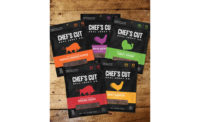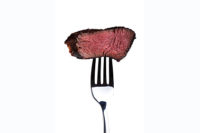Looking Back — and ahead — at Beef Value Cuts
Progress has been made in creating this new generation of steaks. (This is the last column in a series designed to help better market America’s No. 1 protein – beef.)
Industry response to the Beef Value Cuts program has been very positive. Key to the success of this program has been the availability of single-muscle subprimals ready for steak fabrication. Packers must be commended for the significant strides made in sub-primal workmanship. Processors should also be recognized for the unique and creative fabrication alternatives they’ve contributed. Let’s review the six cuts currently in the program:
• The Flat Iron — Cut from the Top Blade, it is the second-most tender muscle in the entire carcass (only to the tenderloin) that carries a delectable, robust beefy flavor.
• The Petite Shoulder Tender — Known scientifically as the teres major, it is a premium cut ideal for upscale casual and fine dining menu applications. Shape and size are similar to the pork tenderloin.
• The Ranch Cut Steak — Known at retail as the Beef Shoulder Center Steak, it has characteristic chuck flavor with a sirloin-like texture. One of its greatest features is its versatility in portioning and menu applications as an entrée, topping for salads, or in a mixed grill plate.
• The Round Sirloin Tip Center — It is comparable in tenderness and flavor to some middle meats. It is excellent for rotisserie application and requires no mechanical tenderizing.
• The Round Sirloin Tip Side — It is a perfect material for country-fried steak and the popular Hispanic milanesa. Mechanical tenderization and marination (10 percent to 15 percent) are recommended to optimize performance.
• The Bottom Round (Western Griller) Steak — This is considered to be relatively tough while it possesses robust, well-rounded beef flavor. Identifying the fiber alignment and cutting across the grain into steaks improves tenderness. Mechanical tenderization, marinating, and cooking to no more than medium-rare doneness significantly enhance tenderness.
• The Flat Iron — Cut from the Top Blade, it is the second-most tender muscle in the entire carcass (only to the tenderloin) that carries a delectable, robust beefy flavor.
• The Petite Shoulder Tender — Known scientifically as the teres major, it is a premium cut ideal for upscale casual and fine dining menu applications. Shape and size are similar to the pork tenderloin.
• The Ranch Cut Steak — Known at retail as the Beef Shoulder Center Steak, it has characteristic chuck flavor with a sirloin-like texture. One of its greatest features is its versatility in portioning and menu applications as an entrée, topping for salads, or in a mixed grill plate.
• The Round Sirloin Tip Center — It is comparable in tenderness and flavor to some middle meats. It is excellent for rotisserie application and requires no mechanical tenderizing.
• The Round Sirloin Tip Side — It is a perfect material for country-fried steak and the popular Hispanic milanesa. Mechanical tenderization and marination (10 percent to 15 percent) are recommended to optimize performance.
• The Bottom Round (Western Griller) Steak — This is considered to be relatively tough while it possesses robust, well-rounded beef flavor. Identifying the fiber alignment and cutting across the grain into steaks improves tenderness. Mechanical tenderization, marinating, and cooking to no more than medium-rare doneness significantly enhance tenderness.
Looking ahead
The following are some of the muscles with future potential in the Beef Value Cuts program:
• Pectinius and adductor — from the Top Round
• Gracilis — also known as the Cap of the Top Round
• Serratus ventralis and the complexus – from the Chuck Roll
• Pectinius and adductor — from the Top Round
• Gracilis — also known as the Cap of the Top Round
• Serratus ventralis and the complexus – from the Chuck Roll
These are only a handful of the muscles that we are investigating in the carcass. Untapped opportunities exist, but obstacles remain that must be fully understood and resolved. As we develop a better understanding of areas such as aging, flavor characteristics, optimal product enhancement, trim yields, and cooking performance, we will return with details on new “Diamonds in the Rough.”
For recipes, cutting videos, merchandising tips, menu suggestions, and more, contact the checkoff-funded National Cattlemen’s Beef Association (NCBA) at 444 N. Michigan Ave, Chicago, IL 60611, (312) 467-5520.
Beef industry new product and culinary center efforts are funded by beef producers through their $1-per-head beef checkoff program and are managed for the Cattlemen’s Beef Board and state beef councils by NCBA. Betty Hogan is the director of new product marketing for the National Cattlemen’s Beef Association, and Tony Mata, Ph.D. is a new product consultant to NCBA.






